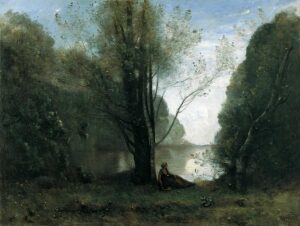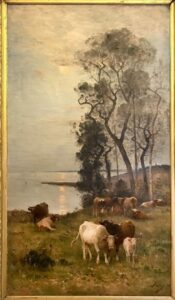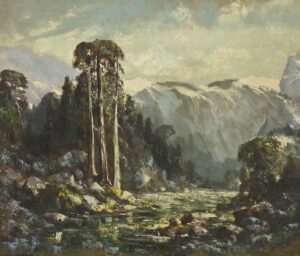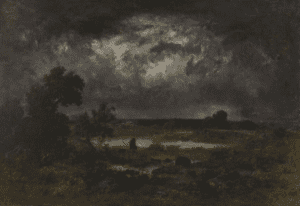The Barbizon School marked a pivotal shift in the art world, favoring the raw beauty of nature over the grandeur of historical scenes.
Nestled in the French village of Barbizon, this movement in the mid-19th century was a forerunner to Impressionism, emphasizing plein air painting and the honest depiction of rural life.
We’ll explore how these artists broke from tradition, their influence on modern art, and why their legacy continues to resonate with artists and art lovers today.
Join us as we jump into the captivating world of the Barbizon School and its enduring impact on the canvas of art history.
Origins Of The Barbizon School
The Barbizon School emerged in the 1830s when a group of like-minded artists found kinship in the rustic village of Barbizon on the edge of the Fontainebleau forest.
These painters were drawn to the unembellished charm of the French countryside, seeking to capture the transient effects of light and atmosphere that many studios in the city couldn’t offer.
We see these pioneering artists as rebels in their own right.
They turned their backs on the rigid formulas of academic art that dominated the Paris Salon, the prestigious art exhibition of the time.
Instead, they plunged into the wilderness, breaking free from the confines of the studio to engage directly with nature in plein air painting.
As forefathers of Impressionism, artists of the Barbizon School forged a path for a new realism in art:
- Theodore Rousseau – his commitment to portraying the forest in its truest form was so intense that many considered him the leader of the Barbizon School.
- Jean-Francois Millet – best known for works like The Gleaners and The Angelus, Millet portrayed peasant life with a dignity and respect that challenged the era’s social norms.
- Charles-Francois Daubigny – his expansive landscapes and riverscapes, often featuring the River Oise, anticipated the full embrace of outdoor painting by the Impressionists.
Inspired by these artists, we jump into the heart of what made the Barbizon School resonate so deeply with those yearning for authenticity.
It was not just about painting landscapes; it embodied a philosophy that valued the simple, true nature of the rural world, unornamented and devoid of grand historical narratives.
As we further explore the works of these artists, we find that the Barbizon School was less a formal institution and more a movement born of shared values and artistic goals.
This collective focus on the natural environment remains influential, perpetuating the idea that there is profound beauty in the everyday, an approach that continues to inform our own work in the world of filmmaking.
Characteristics And Techniques Of The Barbizon School
The Barbizon School artists shared a commitment to painting en plein air – directly observing and capturing the landscape before them.
This practice was revolutionary at the time and contrasted sharply with the studio-bound work that was common.

- en plein Air – Emphasis on painting outdoors to capture natural light and atmosphere.
- Realism – A focus on depicting the rural landscape and laborers as they truly were.
These painters often employed a palette of earthy colors that reflected the tones of the countryside.
The brushwork in their pieces was typically looser and more expressive than the polished academic style, providing a sense of motion and the fleeting qualities of light and shade in natural settings.
Textures within artworks such as The Gleaners became a way for Barbizon artists to convey the essence of the subject matter.
They often used impasto – a technique where paint is laid on thickly – to add dimension and vitality to their scenes.
- Earthy Palette – Use of natural hues to mirror the landscape.
- Impasto – Thick application of paint to enhance texture.
Besides their technical methodologies, Barbizon School members pioneered the integration of mood and atmosphere into their work, anticipating the Impressionists’ fascination with depicting momentary conditions.
The portrayal of weather effects and different times of day in works like Sunset at Sardis introduced a temporal element to their canvases that had rarely been explored before.
Our exploration of the Barbizon School techniques isn’t complete without acknowledging their influence on subsequent movements.
Moments in time, instances of daily life, and the transient effects of light that they captured laid the groundwork for the likes of Claude Monet and Auguste Renoir.
Their legacy in art history is not just one of technique and stylistic innovation, but also one of philosophical shifts in the way nature and human experience were perceived and depicted.
Key Artists And Their Works
In the heart of the Barbizon School, several artists stand out for their pioneering contributions.
Jean-François Millet is known for his profound depictions of peasant life.
His iconic work The Gleaners highlights the back-breaking labor of rural workers, imbued with a sense of gravity and respect.
Similarly, The Angelus evokes a powerful spiritual resonance amidst the everyday struggle of the peasantry.
Théodore Rousseau channeled his spirit into the untamed Wilderness of Fontainebleau.
His mastery in Edge of the Woods at Monts-Girard, Fontainebleau Forest brings to life the raw beauty and solitude of nature.
Rousseau’s landscapes are characterized by a bold composition and moody atmospherics, elements that would echo in later movements.
Other notable painters in the Barbizon School who left their mark include:
- Charles-François Daubigny – whose use of light anticipated the Impressionists with pieces like The Harvest,
- Camille Corot – who blended the Barbizon style with classical landscapes, exemplified in works like View of the Forest of Fontainebleau.
The collective achievements of these artists are a tapestry of interconnected ideas and evolving styles.
They propelled a new approach to art that cherished observation, emotional authenticity, and the candid portrayal of subjects.
Let’s jump deeper into the technical aspects that set the Barbizon School apart from its contemporaries.
Influence On Modern Art
The Barbizon School’s emphasis on realism and nature had a profound influence on various modern art movements.
The plein air techniques and naturalist approach resonated with Impressionists like Claude Monet and Pierre-Auguste Renoir.
Our investigation into their influence reveals an undeniable lineage:

- Impressionists adopted the Barbizon practice of painting outdoors to capture the momentary effects of light and color.
- Barbizon’s focus on daily life paved the way for Realism and Later, everyday subject matter became vital in modern art narratives. Before the Barbizon School, academic art enforced strict rules on compositions and subject matter. Artists like Millet and Rousseau not only pioneered a break from these confines but set the stage for Expressionist and Symbolist movements, where emotional resonance and symbolism took precedence. Elements of Barbizon school artwork informed the developments of:,
- Vincent van Gogh, whose intense emotional landscapes echo Barbizon’s authenticity.
- George Inness, who integrated Barbizon aesthetics into American landscape painting.
These threads of influence indicate the Barbizon School’s role as a cornerstone in the evolution toward both the visual and thematic fluidity found in contemporary art.
Our exploration shows that the ripples created by this 19th-century artistic commune have reached much further than the Forest of Fontainebleau.
Their methods and philosophies laid the groundwork for later artists to express a more personal and emotive connection with their surroundings.
also, the Barbizon School contributed to the narrative of art as a means of personal and societal revelation.
Artists began to see the potential for painting to act as a commentary on cultural and social dynamics, something that has become intrinsic to modern and contemporary art.
This artistic freedom has transcended into our world of filmmaking as well, where visceral storytelling often relies on the same principles of authenticity and naturalism first championed by the Barbizon painters.
Continuing Legacy Of The Barbizon School
The Barbizon School’s influence extends far beyond the canvases of the 19th century; it left an indelible mark on various creative arenas.
We recognize their pioneering spirit in the realm of film, where directors continue to seek authenticity and emotional resonance through naturalistic settings and visual storytelling.
Artists of the Barbizon School aspirationally captured the transient effects of light and atmosphere, principles that have become foundational in cinematography.
Contemporary filmmakers often employ techniques akin to plein air painting, endeavoring to seize the ephemeral beauty of a landscape, much like Jean-François Millet or Théodore Rousseau once did.
- The Barbizon School’s emphasis on mood and setting has paved the way for location-centric narratives.
- Visual echoes of their work appear in the pastoral scenes found in modern cinema.
- Their commitment to depicting genuine emotion resonates in character-driven storytelling.
The visual vocabulary developed by the Barbizon School artists has seeped into the narrative fabric of not just films, but also literature and digital media.
Themes of rural life and the honest representation of humanity find parallels in contemporary genres ranging from Indie Films to prestige television series.
By integrating natural backdrops and focusing on the intrinsic connection between characters and their environment, we tell stories that hark back to the ethos of the Barbizon School.
It’s about creating a sense of place that is as characterful and integral as any cast member, a technique that crescendos into a visual symphony of storytelling.
What Is Barbizon School In Art – Wrap Up
We’ve explored the transformative impact of the Barbizon School, a beacon of innovation that reshaped the art world.
Its legacy endures, influencing countless artists and permeating diverse creative fields.
From the lush French countryside to the broader narrative of art, the Barbizon School’s ethos of emotional depth and natural beauty continues to resonate.
It’s a testament to their vision that today’s filmmakers, authors, and digital artists still draw from their well of inspiration.
The Barbizon School didn’t just capture scenes; they captured the essence of storytelling itself, leaving an indelible mark on the canvas of history.
Frequently Asked Questions
What Was The Barbizon School?
The Barbizon School was a group of 19th-century artists who pioneered plein air painting and emphasized the naturalistic depiction of the French countryside.

They focused on the honest portrayal of peasant life and the raw beauty of nature.
Who Were The Key Artists Of The Barbizon School?
Key artists of the Barbizon School included Jean-François Millet, Théodore Rousseau, Charles-François Daubigny, and Camille Corot.
They were known for their landscapes and peasant genre paintings.
How Did The Barbizon School Influence Modern Art Movements?
The Barbizon School’s focus on realism and nature heavily influenced art movements such as Impressionism, Realism, Expressionism, and Symbolism.

Artists like Claude Monet and Vincent van Gogh were among those inspired by the Barbizon School.
What Impact Did The Barbizon School Have On Storytelling In Different Mediums?
The Barbizon School’s emphasis on mood, setting, and genuine emotion has transcended into filmmaking, literature, and digital media.
Their principles continue to influence contemporary narratives, focusing on location-centric and character-driven stories.
How Has The Barbizon School’s Visual Vocabulary Influenced Modern Genres?
The visual vocabulary of the Barbizon School, with its themes of rural life and honesty, has found its way into various modern genres.
Their techniques and focus on naturalism have influenced the way stories are depicted in film, literature, and digital art forms.
What Is The Legacy Of The Barbizon School In Contemporary Art?
The Barbizon School’s legacy lies in its groundbreaking approach to portraying art with emotional authenticity and overt naturalism.
This has been influential not just in visual arts, but also in the way stories are crafted and narrated across various contemporary art forms.


